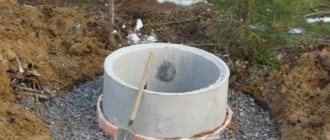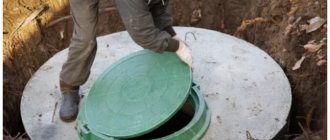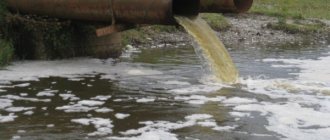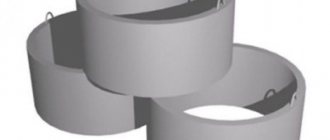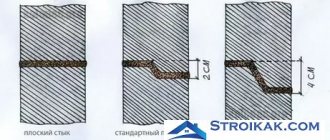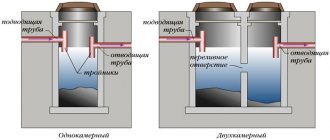Wanting to provide a home or cottage with clean water for drinking and watering plants, many people think about building a well from concrete rings with their own hands, but if there is not enough experience in these matters, it is worth first familiarizing yourself with the construction technology and all possible nuances. In the world of centralized water supply, wells have not outlived their usefulness and continue to be popular, because they are a reliable insurance fund in case of interruptions in the supply of life-giving moisture, and sometimes their only source. Wells are a guarantee that there will always be fresh water in your house or dacha.
A well is the most important building in a dacha: it will provide you with water for irrigation, summer showers and cooking
Of course, only on condition that it is made in accordance with the technology and is maintained according to all the rules. From the point of view of technical aspects, there is nothing overly complicated in building a well, but the physical work will be very difficult.
Choosing between a well and a borehole
It's hard to answer the question which is better. In each individual case, many factors influence the decision.
To get a water source, you need to choose between a well and a borehole
- Water depth. Typically, the depth of the well does not exceed 15 m; if the aquifer is located below, then for economic and practical reasons you can think about a well.
- Self-construction. For a person without experience, the construction of a well will be clearer and easier to perform than the process of drilling a well.
- Obstacles. There is another important point - underground stones. If you come across one along the course of the drill, then it will be very difficult, and sometimes impossible, to get through it. In the case of a well and its large shaft diameter, the situation is simpler.
- Equipment. No special tool is required for digging wells.
- Service. The bottom of a well or well will silt over time, and it’s easy to guess which structure is easier to clean.
- Business interruptions. The well does not have these (subject to regular cleaning), but the supply of water from the well often depends on the operation of the pump, if it is electric.
Installation of rings
It is impossible to install concrete rings weighing 450 kg manually, but with the help of a homemade tripod, everything worked out. Board 100x25x4000 mm, double for each leg, with screws. In the upper part there is a 38 mm hole, a reinforcement rod with a diameter of 16 mm is inserted into it, and a hoist is placed on it. When lifting the rings, the device performed perfectly, did not wobble or even squeak.
Before lowering the ring onto the filter, ani1883 placed three wooden blocks. I mixed the solution (1/4), poured it into the gap between the ring and the brick filter, lifted the ring with a hoist and pushed the spacers inside. I lowered the ring again and filled the void with mortar, after which I carefully rubbed the seam inside and out. The next ring was rolled along the boards to a distance of its diameter from the well and, using a tripod, turned over on its side.
ani1883FORUMHOUSE Member
To do this, the tripod is rearranged so that its center is a meter away from the ring that needs to be overturned. First, I secured the cable to the mounting hooks of the ring, and then slowly pulled out the cable with the hoist, the ring rises, slowly stands on its edge and tips over. The hoist is lowered and the cable is released.
In the next step, the tripod is placed above the center of the well. The ring is secured again and slowly rises. During this operation, the ring itself slowly moves up and falls into place. You just need to help him a little to get exactly in place. Before installing the ring in its place, a 1/4 solution (cement-sand) is laid and placed on the lower ring, and a new ring is lowered on top. Then all seams are rubbed with mortar. And so on until all the rings take their place.
A little about accessible aquifers
Diagram: occurrence of aquifers
- Verkhovodka. It is located closest to the surface and is replenished due to precipitation, which is why its fullness is constantly changing, and during dry periods and in winter it can disappear completely. In addition, it is susceptible to pollution by wastewater treatment plants.
- Ground. They lie at a depth of 6-20 m and are located between two waterproof layers, but do not have excess pressure, so the water level in the well shaft remains practically unchanged. Only minor changes are observed at different times of the year.
- Artesian waters are located at a considerable depth, are strongly squeezed between two waterproof layers, which is why they are under pressure, and when the formation is pierced, they gush out to the surface. The quality of the water is beyond doubt, but the construction and maintenance of a well of a special design is usually not cost-effective.
Video description
About fastening well rings with staples in the following video:
- Crowbar, pickaxe. They will be needed if you come across a layer of dense or rocky rock.
- A bucket and a cable for lifting soil, a wheelbarrow for removing it.
- Rope ladder for descending into the mine, lantern, tape measure.
- Winch or well gate, slings for installing rings (for the open method). Mechanization can also be used to lift soil to the surface.
- Vertical control tool. The easiest way to check the vertical is with a plumb line with a cord; you can use a construction spirit level (level).
- Drainage pump for pumping out water entering the mine.
- Tool for sealing seams.
- To attach the brackets you will need a hammer drill and bolts.
Digging a mine requires compliance with safety regulations: it is recommended to work with a partner: one performer is underground, the other is insuring from above. Safety precautions also require the use of a helmet and a safety belt with a cable.
Preparing the ring for descent Source kanaliza.ru
How to choose a place for a well and when to start digging
There is a whole arsenal of folk methods for finding water and determining the location for a well, most of them are not questioned, and dowsing is still popular to this day. Experts recommend, at a minimum, asking neighbors or independently measuring the depth of nearby structures. But only exploratory drilling can guarantee an accurate result. The well must be located on the site in a place where it is not at risk of contamination by domestic wastewater (for example, far from the country toilet).
Detection of aquifers using the folk method - dowsing
In addition, it should fit perfectly into the landscape design. It is not recommended to start construction work in the spring, since due to fluctuations in groundwater content, you can make a mistake with the depth. The optimal time is considered to be the end of winter, but not later than March. Work can also begin at the end of summer.
Characteristics of reinforced concrete rings
Reinforced concrete rings from which water wells are installed are manufactured in accordance with GOST 8020-90. It establishes a list of technical characteristics of prefabricated reinforced concrete rings for wells. These types of workpieces have a number of differences from each other, for example, in diameter, which can be 750-2000 mm in increments of 250 mm. If we take into account the height of the rings, the standard parameter is 800-900 mm. Reinforced concrete products, namely rings, are divided into 2 subgroups:
- with a lock at the end;
- without a lock.
The lock ensures the creation of a more airtight connection of reinforced concrete rings with each other. The structure is durable and airtight. Products without a lock are secured with metal staples. In general, reinforced concrete rings have the following advantages:
- strength and reliability of elements;
- short duration and ease of installation.
The service life of prefabricated reinforced concrete rings for the construction of wells is calculated in decades in any climatic conditions, if they are manufactured in accordance with GOST. This characteristic depends on the properties of the reinforced concrete used. The disadvantage of the products is their significant weight, although this characteristic is not considered critical. The estimator, when determining the number of blocks required for construction, first calculates the volume of reinforced concrete rings for wells. To do this, you can use the following formula:
V = Lx3.14xR (where V is the volume of the well, L is the height of the structure, R is the radius).
The exact price for reinforced concrete rings is set depending on their volume. Usually the norm is 0.16-0.54 m. And the volume of the future structure depends on the size of the rings.
Construction of a shaft-type well
The design of the well is quite simple, but this should in no way affect the accuracy of the calculations, the quality of the work and the responsibility in its execution. Conventionally, wells can be divided into three main components:
- The water inlet - as the name implies, serves to filter and collect water.
- The trunk is the entire structure of the well in the thickness of the soil above the receiver.
- The head is the above-ground part, which is equipped with a lifting mechanism and a roof that protects the shaft from debris.
Scheme: well construction
Laying water pipes and cables
It is necessary to dig a trench 40 cm wide. A water pipe with a diameter of 50 mm is laid in this trench. You can insulate the pipe with polystyrene foam.
Then concrete rings are placed in the hole. Heavy equipment is used to install them.
A hole is made in the rings for the pipe and cable. In order to lay the electrical cable, a hole is drilled with a hammer drill 20 cm above the hole for the water pipe. After the water pipe is laid, it is covered with a 20 cm thick layer of soil.
Then a three-core copper cable is laid in the hole, and the trench is completely covered with soil. The gaps between the rings must be filled with foam.
Types of water intake, which one to choose?
The water intake of a conventional mine well is of three types:
- An incomplete water intake is the most common option and means that the shaft does not reach the lower impermeable layer, and water seeps through the bottom and wall.
- The full water intake reaches the waterproof layer and water seeps only through specially prepared walls of the shaft.
- A full water receiver with an expander is a structure that not only reaches the lower water-resistant layer, but also goes deep into it, forming a niche for accumulating water reserves. Its lower part is often made expanded.
Scheme: types of wells by type of water intake
Important! To think that the more water in the well, the better, is completely wrong. It is important to correctly calculate the balance between daily consumption and volume, otherwise stagnation with all the ensuing consequences is inevitable.
Briefly about the main thing
Construction of a well is a labor-intensive and costly process. In order for the costs to be recouped and the owners to have access to clean drinking water for a long time, it is necessary to carefully choose the place, time and digging technology.
To dig a well on your own, without using equipment, choose a shaft structure. A shaft of suitable depth can be obtained by two methods, open and closed. The first method involves preparing a shaft and then lowering reinforced concrete rings into it. In the second case, the shaft is deepened while tiers of rings are simultaneously built up. In both cases, a sand and gravel bottom filter is installed.
Material for mine wells
A well shaft can be made from many materials. Previously, it was stone or wood, later brick appeared, and recently the most popular is a well made of concrete rings. The disadvantage of stones is that they are inconvenient to work with; in addition, their cost leaves much to be desired, as is the case with natural wood.
Concrete rings for well construction
Brickwork is a rather labor-intensive process, and the material itself must be of high quality and have good water resistance. In the case of brickwork, it is very difficult to achieve good waterproofing that will not let water into the shaft. Concrete rings make it possible to simply and much faster build a well that will meet all the requirements for technical, sanitary and hygienic standards.
Well care rules
Do not forget about the hygiene of well water supply. Since you use the extracted water for drinking, proper care of the source is important. Follow the guidelines below to keep your well free of contamination:
- If any item is found at the source, it should be removed immediately. To do this, use a long rope with a hook at the end.
- When you have small children in your family, it is important to protect them from falling into the well. Forbid them to run near it, lock the lid.
- Animals often fall into wells. Be sure to pull it out, and then pump out the water and disinfect the source. Then it can be refilled with water. To prevent the animal from falling, create a fence.
- It is necessary to carefully inspect the source annually, and ideally twice or thrice a year, to detect contamination on the walls. To inspect, you will need a bright flashlight; you need to lower it into the well and inspect the walls.
- To prevent particles of dust, leaves and other contaminants from getting into the well and to keep the water clean, always cover the source. To do this, you need to equip a wooden or plastic cover. The optimal solution is to build a special house with a mini-door yourself.
When you plan to go down into the well, be sure to take an assistant with you to help you at the top. To go down at 11:00 you will need a strong ladder or rope.
Before going down, make sure that no toxic gas has accumulated in the well. To do this, light a candle and lower it on a rope. If the candle flame below has not changed, then everything is in order. But when the candle goes out, it means that the gas concentration exceeds the permissible values. Do not go down into the well under any circumstances, this can lead to death!
How to remove gas accumulated in a well? To do this, use a home vacuum cleaner. You can also use a potbelly stove, but the effectiveness of this method will be lower. It is placed next to the well, a pipe is inserted into the ash pit and lowered to the water's edge. Then you need to heat the stove strongly, then the gas will come to the top.
If after checking it turns out that there is no gas in the shaft, start cleaning the well. To do this, you need to go down and use an iron brush to remove moss and dirt from the walls. After this, use a fine mesh to collect debris from the bottom. After this, you need to wash the walls with water. At the bottom of the well there is a sand and gravel filter layer. It needs to be replaced, or you can take out the old filter, wash it and lower it to the bottom again. The final stage is disinfection and removal of water. The liquid may have to be pumped out 2-3 times before the well can be used.
Periodically, the water in the source stagnates. This happens when the well is not used actively enough. This water is not suitable for drinking. To clean the source, the stagnant liquid should be pumped out. To prevent this from happening, a ventilation pipe with a cross-section of 0.2 m is lowered into the shaft. It is important that its lower end does not reach 15 cm from the water, while the top of the pipe should exceed the edge of the well by 1–1.5 m. To prevent debris from entering into the pipe, the upper edge should be covered with a mesh.
Remember that it is important to regularly take your water for laboratory analysis. Even if the liquid at first glance seems clean and does not smell of anything, its chemical composition may be far from ideal.
;
Water supply
Did you find this article helpful? Share it with your friends:
Safety Basics
Inexperienced homeowners often neglect basic rules and endanger not only themselves, but also their partners. To avoid ridiculous injuries, you need to follow at least some basic rules.
- A person in a mine must protect his head with a helmet. Anything can happen; a bucket falling down or a tool falling down is not uncommon.
- Ropes, ropes, ropes, rings - everything related to lifting is carefully checked before starting work.
- A person dripping in a shaft must be secured with a rope, and if the depth of the well is over 6 m, then with two: a working rope and a safety rope.
The construction of a well must be carried out by several people
- There are so-called gas pockets in the soil, and since the air exchange in the mine is not fast, as you descend, they periodically light a candle. Its flame should burn evenly, which indicates a sufficient amount of oxygen; if the fire goes out, the pit needs to be checked.
Advice! There are several ways to ventilate a mine. The easiest way to do this is with a thick blanket, which is lowered to the bottom several times and raised back on ropes. A fan lowered to the bottom of the shaft will also help speed up gas exchange.
Design selection
There are two types of well structures: shaft and tubular. The mine water intake has the following features:
- This is a vertical well of round or square shape with reinforced walls. The water receiving (lower) part is buried in the aquifer.
- The shaft design of local water intake is more widespread, since construction costs are lower and operation and maintenance are simpler.
- The design is considered the best option. It is easier to equip it without the use of construction equipment; a gate or pump is used to lift the water.
A tube well is a borehole that is reinforced with water casing pipes secured with couplings. It is equipped if the water layer is located no deeper than 4-6 m. The advantage of a tubular water intake is its accelerated construction. It can be built close to home, and it is less polluted. The disadvantage of this option is the need to attract drilling equipment.
Reinforced concrete rings - a universal material for well construction Source berizon.ru
Technology and stages of constructing a well from concrete rings
It is unlikely that anyone is going to pour concrete rings on their own, because this is not only a complex and time-consuming process, but also meaningless. It is much easier to buy ready-made products in the required quantities, which can be easily calculated, knowing the depth of groundwater.
Advice! An incomplete well made of reinforced concrete rings is the most popular option, not only because of the ease of installation, but also due to the price-quality ratio.
Construction of a well with alternate installation of rings
The mine is always dug manually with a short-handled shovel; such a tool will be much easier to operate in a confined space. When a hole of the appropriate diameter is about half a meter deep, check the evenness of the bottom and install the first ring. It is important that it is exactly in the middle of the shaft and does not rest against one of the walls. After this, they continue to dig out the earth, but already inside the reinforced concrete product. As the soil is excavated, the ring will gradually deepen under its own weight and when the upper edge reaches the ground level, the next ring is installed on top of it and secured with staples.
Construction of a well using the method of alternate installation of rings
It happens that a hole is dug, but the ring does not go down. This means that it is located at an angle from the vertical axis. You can correct the position by placing a shield on top and throwing stones or bears of soil on the side that needs to be besieged. When the ring begins to sag, the excess is removed. They continue to go deeper. And so on until water begins to seep through the bottom of the shaft. They continue to dig for some time, pumping out the arriving water with a pump. Work is stopped when the mine reaches the first aquifer. Water will begin to flow very quickly. But they continue to pump it out so that it is possible to level the bottom and install a bottom filter, if necessary in a particular case.
Installation of rings into a finished shaft
There is another construction method, when the rings are lowered one by one into a shaft completely dug to the aquifer. But this method is less popular and is not possible on all types of soil. It is also dangerous that at any moment, even before laying, the earth can collapse. Concrete rings are lowered into the pit by crane, placed end to end on top of each other and secured with steel brackets around the circumference of the connection.
Well construction method: installing concrete rings in the shaft
Internal waterproofing
All seams between the rings are sealed with mortar or a special ready-made compound. When lubricating them, do not forget about cracks and holes, which under the influence of moisture will quickly collapse and cause depressurization of the mine. It is strictly not recommended to use solutions that contain bitumen, as they can significantly spoil the taste of the water.
Processing the seams of a well made of concrete rings
External waterproofing of the well
Waterproofing the well from the outside will prevent water from entering the shaft. For this purpose, a so-called clay castle is made. Around the last rings, a trench is dug about 0.5 m wide and 1.5-2 m deep. Clay is poured into it and compacted tightly. As a result, it should lie slightly above the soil level closer to the well, and ensure that precipitation flows along the slope from the mine.
Scheme: external waterproofing of a well
The site is concreted. Over the next 2-3 weeks, the water must be pumped out several times. It can be used for household needs, but for drinking purposes it is better only after conclusion from the laboratory.
How to make a “knife” with a filter
ani1883 and his son began digging the well and started with the construction of the knife.
ani1883FORUMHOUSE Member
Before digging a pit, the diameter of the future well is drawn. It should be taken into account that the diameter of the knife should be 10 cm larger than the diameter of the concrete ring for the well. Thus, the diameter of the pit is 10-15 cm larger than the diameter of the rings for the well.
First, we made approximate markings and removed the fertile layer down to the clay, leveled the bottom and drew the boundaries of the future knife. If the outer diameter is tied to the dimensions of the rings, then the inner diameter is tied to the length of the brick from which the filter will be assembled - for ani1883 the inner diameter is approximately 60 cm.
Next, along the inner diameter of the knife ring, the soil was carefully dug up and selected with a shovel, and then dug under the cone towards the larger diameter. Having selected the main volume of soil, we used a garden scoop to draw out the vertical wall and the “nose” of the knife.
The solution for the knife is self-mixing, the ratio of cement to sand is 1/4, with a minimum of water to wet the components. The solution was poured directly into the ground, the released water helped to remove the horizontal level of the solution. In total, it took three batches - three garden wheelbarrows of sand and three ten-liter buckets of cement.
A week later, when the concrete had set, a filter was laid - three rows of solid ceramic bricks. Before laying, “try on” dry, lay the masonry itself on a weak solution of cement and sand in a ratio of 1/7. The bricks of the first row are laid in a fan, the voids are filled with coarse sand, the second row is laid with the gaps of the first being covered, and the voids are also filled with sand, and the third is done similarly.
When is a bottom filter needed, and what should it be like?
In order for the water in the well to remain clean and transparent, it is not necessary to install expensive purification systems; it is enough to resort to a time-tested method, namely the organization of a bottom filter. It is a layer of stones of different fractions that retain impurities, allowing only purified water to pass through. The method of arranging the filter depends on the type of soil at the bottom of the mine, the volume of groundwater and the rate of its flow.
Bottom filter device for a well
- Dense clay bottom. Such soil is not eroded by water and is supplied in its pure form, so the well does not need an additional filter. Moreover, it can cause harm by blocking the keys.
- The soft clay bottom can be eroded by active currents, causing the water to become a little cloudy. A layer of crushed stone about 20 cm high will help correct the situation.
- A sandy bottom, through which water seeps slowly, always needs a filter, which is laid in several layers. The first will be washed sand, the next layer will be filled with small pebbles, gravel or shungite up to 1 cm in size, and the last will be crushed stone or stones with a size of 5 cm or more. The height of each layer is 15-25 cm.
- A float at the bottom of the mine. Actually, this is the same sand, but washed away by water to an almost liquid state. In such wells, in addition to installing a bottom filter, it is often necessary to install a wooden or more modern metal shield with holes about 1 cm in diameter. It is lowered to the bottom, and a 15-20 cm layer of large stones and small pebbles is poured on top.
What you need for work: materials and tools
Before digging a well by hand, you need to prepare the following materials:
- Reinforced concrete rings of suitable diameter (usually 1 m). As for the height, it is better to choose the minimum: this will not affect the quality of the structure, and it will be more convenient for you to move and install them. Rings of small height have a disadvantage: there will be more seams, which means it will take more time to seal them.
- Materials for the bottom filter: gravel (fine and coarse fractions), sand.
- Fastening material for joints of rings: thrust staples (three staples for each joint), cement mortar for sealing seams.
- Materials for waterproofing.
You will need the following tool:
- Shovels with a shortened handle: bayonet for digging, scoop for excavating soil.
Tools for excavation work Source termopaneli59.ru
The header is beautiful and functional
The final stage of the construction of any well will be the installation of the head - a beautiful and functional part. The head is based on a primitive lifting mechanism, but is also designed to protect the source from contamination. If beautifully executed, it can become an excellent decorative element on the site. Also, at the construction stage, it is advisable to think about organizing the water supply to the outdoor shower, if there is one on your site.
The well head is designed at the discretion of the site owner
To organize the head of the well, the upper ring of the well should protrude 60-80 cm above the surface. But in the first year after construction, it is not recommended to arrange the site, since the ground may still subside a little. A temporary lift with a good roof is being built. You can make a head or house for a well yourself or purchase a ready-made one. As a rule, they are sold disassembled, but assembling all the parts is not much more complicated than a children's construction set.
Stage five. Setting up a well
But the construction of a well is not limited to drilling a mine and strengthening it. To do this, we arrange the upper part of the structure - the head.
Insulation of the well head
We will equip a blind area around the well - a small platform made of concrete or carefully compacted crushed stone. The blind area must extend at least 1 m from the shaft on each side and, importantly, is constructed a certain time after completion of construction, when the soil settles.
Blind area around the well
Scheme of structural layers of the blind area
Blind area made of a mixture of crushed clay and crushed stone
Insulation of the blind area
We also build a canopy over the structure to prevent precipitation from entering the mine. If a pump is used to supply water, it is better to close the shaft completely, leaving a small hole for the hose and cable.
The process of building a well with your own hands: photo
Sealing joints
Such work should not be carried out across the entire depth of the well. As a rule, the lower few rings (if their total number is approximately 10) are left as is. The rest, located above, must be sealed. This is necessary so that various liquids that enter the soil due to rain or melting snow do not enter this source ahead of time. They must pass through all layers of soil and, after cleaning, be used for their intended purpose. In the lower part, clean water can pass through the gaps between the rings, so their joints are left unsealed.
The materials used to seal joints are cement mortar and liquid glass.
Standards and requirements
When selecting a location for the construction and installation of a hydraulic structure, it is necessary to strictly adhere to the rules of SNiP 2.04.02-84. According to them, the distance from the well shaft should not be less than:
- five meters - to the foundation of the house;
- four meters – to buildings for animals and garden trees;
- meter - to shrubs and garden beds;
- meter - to any outbuildings on the territory.
Septic tanks or cesspools are located at least 50 meters away from the water intake structure. At the same time, treatment facilities cannot be located higher in relief than water supply wells.
According to building codes, the well shaft must be covered with a lid. This is necessary to prevent sediment contamination of the water in the structure, as well as to ensure the safety of children and animals.
To avoid the penetration of surface water, the water intake device is mounted so that its top is raised on the ground surface by at least 0.5 m.
What is needed for the device?
Before starting work on the construction of a concrete well, it is important to determine the correct and correct location. To make this decision, it will be necessary to conduct research to determine the presence of water underground, as well as at what depth it is located. After this, you will need to find out its quantity and quality.
The location of the future well should be no closer than 35 meters to sources of manure or various organic waste. You should not build wells near rivers, on slopes or in ravines. This threatens the ingress of groundwater. When you have decided on the location, you need to obtain permission from the authorities responsible for this.
Such devices are made in two ways. The first method is construction from monolithic concrete, and the second - from precast concrete. Precast concrete is a ring of reinforced concrete that is produced in industrial workshops. Factories in our country produce rings of different types and sizes. In the production of monolithic wells, the process takes place directly at the installation site. This method of constructing a device is much slower and more labor-intensive. If you make the device from prefabricated rings, the process will be more economical, convenient and quick. Such a well is not in danger of destruction of the walls or ingress of various pollutants. To find out the required number of rings, it is worth starting from the depth level of the aquifer.
It is also worth giving a list of necessary tools and materials:
- rings of the required size;
- various types of filtrates;
- substances for waterproofing well walls;
- sealant for seams and cracks;
- shovels;
- buckets;
- winch;
- workwear;
- level;
- trowel;
- wooden boards;
- roulette.
Return to contents
Blind area
Crushed stone is poured on top of the clay in a layer of 20 cm, and then a concrete screed is poured on top of it. What is it for?
With the help of such actions, you can not only give an aesthetic appearance to the outer part of this structure, but also additionally protect it from liquids located in the upper layer of soil. Even in rainy weather, near such a water source will always be relatively clean.

